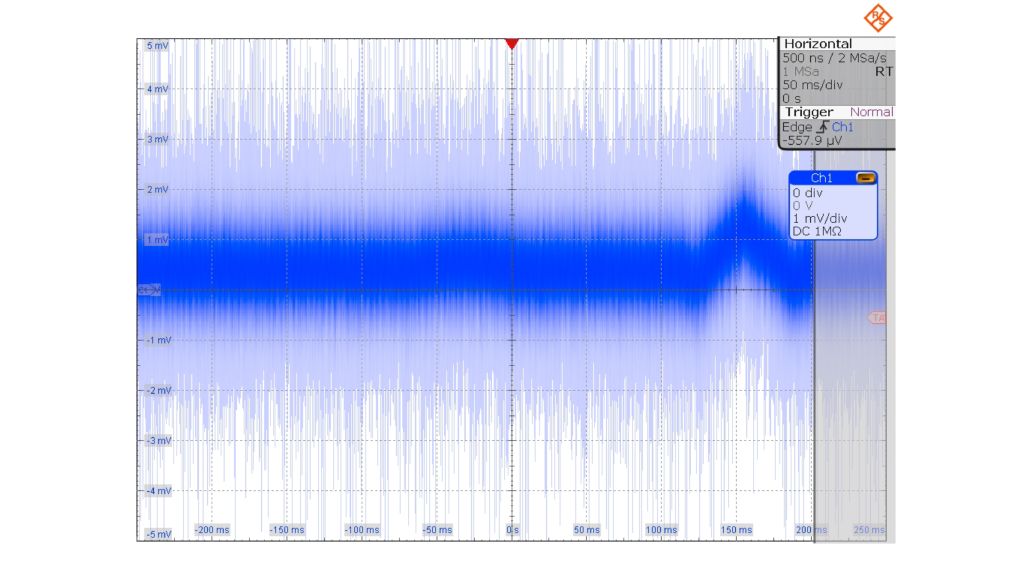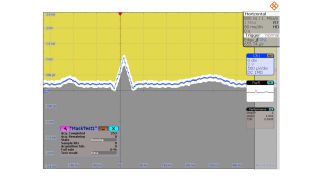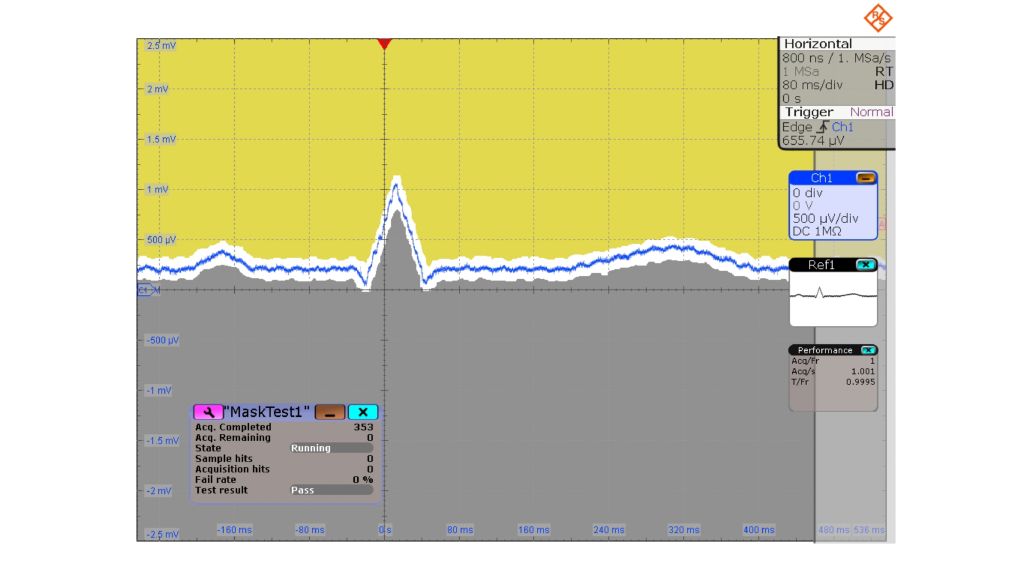Your task
An electrocardiogram (ECG) is widely used in medicine to monitor small electrical changes on the skin of a patient’s body arising from the activities of the human heart. This simple and noninvasive measurement easily indicates a variety of heart diseases. The medical industry builds dedicated equipment that aids in diagnosis. This equipment requires precise oscilloscopes for its design and verification.
T & M solution
ECG equipment typically has 12 leads that are connected to the human chest, arms and legs. The voltage is measured between different connection points. This article describes the example of signal lead 1, which is the voltage between the left and right arms.
The figure on the left shows this signal (lead 1), which repeats with the pace of the heartbeat. It starts with a P wave, which initiates the cycle, continues with the QRS interval and completes with the T wave. For a test engineer, the noisy environment, the single-ended connection of the leads and the low magnitude of the signal create quite a challenge. Typical levels are less than 1 mV, and the repetition rate of the heartbeat signal is between 40 beats/minute and 220 beats/minute (bpm).
In a typical setup, an amplifier is required to amplify the signal, with the drawback of additional noise, channel-specific delay and offset error. However, waveform averaging is not a choice for noise reduction, because the signal is not repetitive and important information would be lost. The diagram shows an example of a sequence of pulses with nonperiodic disturbances, providing medical personal with valuable indications to specific diseases.


Nonperiodic disturbances in a periodic ECG signal
The typical ECG signal magnitude is 1 mV or less depending on the measurement point, with a bandwidth < 10 kHz. Capturing and analyzing these signals directly with oscilloscopes is difficult due to the small amplitude.
However, the R&S®RTE digital oscilloscope offers key features for direct, in-depth signal analysis.


Captured ECG signal after executing the Autoset.
Application
The screenshot shows an ECG signal captured with the R&S®RTE in a standard setup. The signal has a high noise level, the P and T waves being barely visible.
To improve the acquired signal, the vertical scale is set to 500 μV/div without zoom or bandwidth limits. This is a unique feature for this class of oscilloscopes. The HD mode is used with a 10 kHz bandwidth limit.
This increases the resolution significantly, but also improves the trigger sensitivity, which is necessary to obtain clean and stable signal acquisition for further analysis.
Use of mask test for easy detection of medical indications
Further tests can be carried out using this stable signal. For example, a mask test easily detects several medical indications appearing in a distorted signal. Different masks can be applied to test for specific indications. The screenshot shows the ECG signal with the associated mask test, derived from a healthy human. The white area around the signal trace is the permissible area; the colored areas (top and bottom) are the upper and lower masks.


Captured ECG signal using 500 μV/div scale, HD mode and mask test.
Note the performance indicated as 1 frame/s and 1 acquisition/s in the performance icon, which equals a heartbeat rate of 60 bpm. In this setup, the R&S®RTE triggers, acquires and processes every single pulse, although the acquisition time occupies 80 % of the period of 1 s, leaving just 200 ms for processing. This example shows the outstanding performance of the R&S®RTE.


ECG signal
Comparison with a competitive, modern highresolution oscilloscope
In an identical measurement setup, the R&S®RTE was replaced with a competitive 10-bit, high-resolution oscilloscope. The screenshot below shows the measurement result with HighRes mode switched on and the lowest vertical resolution of 1 mV/div.
It turns out that the signal magnitude is lower than the trigger sensitivity, so the oscilloscope cannot trigger on the signal. To make this visible in a screenshot, the display persistence is increased to several seconds, and the trigger level is shown as a light blue dashed line. Previous traces are visible as shadows (1).
The applied filter, implemented in the digital signal postprocessing, shows insufficient bandwidth, so spikes from the measurement setup are not filtered out (2). Number 3 indicates the noise and limited vertical scale of 1 mV/div. As a consequence, the P wave of the signal is barely visible and is immersed in the noise.
Summary
The R&S®RTE is the best choice for analyzing small signals such as ECG signals with high signal fidelity. It is wellsuited for medical applications. The frontend provides excellent low noise values and, at 500 μV, the lowest vertical scale in its class. The analysis requires no additional circuitry, and the HD mode increases the vertical resolution, improves the trigger sensitivity and reduces the inband noise power. This lets the user capture signal details that are important for analysis. The R&S®RTE is superior to competitive high-resolution oscilloscopes in this respect.





